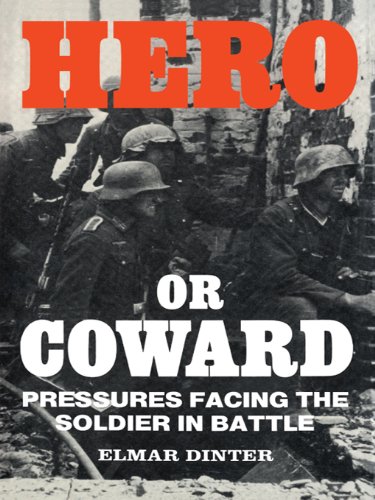
Elmar Dinter’s Hero or Coward addresses the complex question of why some men fight well in war and others do not. Dinter’s premise is that ‘at its core, war is a battle of minds’ and the will to fight is the critical factor in battle, however, why some men maintain a will to fight and others do not is unclear.[1][2]
Dinter believes that understanding this issue is important. He argued that a few men in the frontline decide the outcome of battles.[3] He notes that ‘this has not changed since the introduction of national mass armies and the machine gun…Modern technology will make no difference to this as long as weapons have to be operated by soldiers, who by doing so must bravely risk their lives’.[4] In the future ‘victory will be gained only by the side which concentrates on the maintenance or improvement of the will to fight of the front-line soldier, the quality of his physical and psychological abilities.’[5]
His starting point is that battle is incredibly stressful on individuals. The ‘omnipresent fear of the unknown and the unexpected [on the battlefield]…results in the desire to flee’. Soldiers react in two ways to this stress; they are either ‘drivers’, ‘who use…[their] weapon and takes the initiative’, or they are ‘passengers’, soldiers ‘who remain…passively at his [the driver’s] side’.[6] However, for all soldiers there is a physical limit as to how much stress they can endure on the battlefield, eventually all soldiers become exhausted.[7]
Determining which individuals will fight or will fold is very difficult.[8] He argued that Second World War research by SLA Marshall suggested only 15% of men fired their weapons, which he concluded was a ‘sobering thought’.[9] Dinter argued that whether men pursued ‘activity or passivity are a matter of inheritance, the influence or background or of education.’[10]
However, what is also clear from research is that some units fight better than others similar circumstances. The factor that is prevalent in the units which perform better are high levels of small group cohesion as this is ‘the deceive factor for combat efficiency.’[11][12]
While ‘the average soldier would really like to run away from the fighting. The group prevents him from doing this.’[13] The group has a strong magnetism for men to counter the terror of the battlefield as the ‘strongest emotional force in this socially constituted group is the desire of each of its members for love, friendship, sympathy, recognition, respect and power’.[14] The group is also the individuals best guarantee of survival as ‘together it is easier to protect oneself from [harm]…than alone.’[15]
Dinter points out a number of implications from his study for the organisation and training of peace time forces for war. All efforts should be focused on the ‘front line soldier’ and the ‘the main aim of the organisation should be the creation and the maintenance of group cohesion’. Personnel need to be selected carefully and those with obvious factors in their personnel histories, such as drug addition, that may make them poor soldiers should be carefully considered as they ‘could fail under the pressures of battle’.[16] He also argues that training should be realistic and aim to test dormant abilities. Finally, he argues that the enemy in conflict should be given the opportunity to surrender where possible without ‘feeling dishonoured’ as this is an efficient method of weakening the enemy.[17]
However, there are some weaknesses of the work. Firstly, the evidence base from which Dinter draws his evidence is narrow. He illustrates his narrative with examples drawn from three Second World War battles; Stalingrad (1942-43), Dunkirk (1940) and Monte Cassino (1944) and features a small selection of texts written by men who had fought in these engagements.
Secondly, some of his metaphors for describing some of the concepts he seeks to put forward may not work for all. For example, to describe the range of stressors on soldiers in battle he uses a metaphor of a rain cloud which he titles the ‘Cloud of Pressures’ that ‘consists of the primary, all important fear of physical and psychological isolation, the almost equal fear of the unexpected and the unknown, the still considerable fear of mutilation and, finally, of those physical deprivations…which lack of sleep and noise appear to be the most consequential’. When this ‘dark, heavy rain cloud rains’ it can empty into the ‘Lake of Complete Physical and Psychological Exhaustion’.[18]
Thirdly, his reliance on the work of Marshall is problematical as many scholars have shown that Marshal’s methodology and conclusions are suspect.[19]
Finally, Dinter’s work is very much rooted in the Cold War and does not date well in the light of recent scholarship. It is part of a large body of work that emerged in the 1980s to that was following the fashion of the time to support small group cohesion as the basis of combat motivation.
Despite these minor problems, Dinter’s work is thought-provoking as he tries to explain how men operate and function under the extreme stress of combat and why some men can function and operate under such conditions and others cannot. Importantly, he offers some practical solutions as to how military organisations may manage this problem.
[1] Elmar Dinter, Hero or Coward, Pressures Facing the Soldier in Battle (London: Frank Cass, 1985)., p.9.
[2] Ibid., pp.17, 3.
[3] Ibid., p.16.
[4] Ibid., p.87.
[5] Ibid., p.88.
[6] Ibid., pp.20-21.
[7] Ibid., p.28.
[8] Ibid., pp.27-28.
[9] Ibid., p.19.
[10] Ibid., p.20.
[11] Ibid., p.40.
[12] Ibid., p.110.
[13] Ibid., p.50.
[14] Ibid., p.41.
[15] Ibid., p.41.
[16] Ibid., pp.90-91.
[17] Ibid., pp.109-110.
[18] Ibid., p.60.
[19] Roger J. Spiller, ‘S.L.A. Marshall and the Ratio of Fire’, JRUSI, 133 (Dec. 1988), pp.63-71; John Whiteclay Chambers II, ‘S.L.A. Marshall’s Men Against Fire: new evidence regarding fire ratios’, Parameters 33 (Autumn 1993), pp.113-121; Robert Engen, Canadians Under Fire: Infantry Effectiveness in the Second World War (Montreal & Kington: McGill-Queen’s University Press, 2009), pp.19-22, 146-149.

